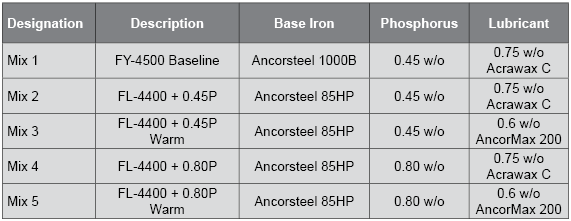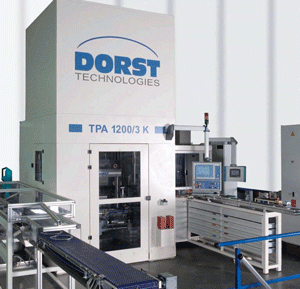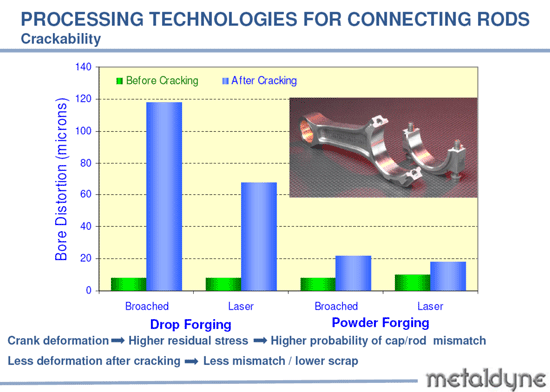PM-13 India: Developments in Powder Metallurgy processes and products
Soft magnetic PM products
During the PM-13 conference it was evident that there seems to be an increase in interest in magnetic products. Klaus Dollmeier and Ian W. Donaldson, GKN Sinter Metals, and Peter Sokolowski, Hoeganaes Corporation, presented a paper entitled “Soft magnetic powder metal materials and their processing for elevated strength requirements.”
The authors stated that typical routes for the strengthening of ferrites in Powder Metallurgy, such as the addition of carbon, copper or through strain hardening result in a decrease in soft magnetic properties and hence are not feasible alternatives. A solution is found through the development of prealloyed Fe-Mo-P powders. The addition of P to Fe to stabilise the body centre cubic (BCC) structure and form a liquid phase at typical sintering temperatures (1120°C) resulted in rapid densification and pore rounding. This also led to grain growth and improves soft magnetic properties. The addition of molybdenum improved mechanical properties.
The effect of the prealloyed Mo with the 0.45 and 0.80 w/o P resulted in the permeability and coercivity both being improved for the same density at a drive field of 7958 A/m. At the higher density, the soft magnetic properties are improved.
Sinter hardened materials
Sinter hardening and the hardenability of sintered steels also seems to occupy substantial interest. “Improving the hardness of un-alloyed iron PM parts by a new low temperature gas alloying process without rapid cooling” was presented by N. Gopinath, Fluidtherm Technology, India. This is a novel post sintering in-line (patent pending) process developed to produce high strength, low distortion unalloyed iron PM parts with a structure of hard transformation products eliminating subsequent heat treatment.
Hardness, wear, crushing strength and metallography of Fe-2% Cu samples of 6.8 and 7.2 g/cc density with different carbon contents from several production scale trials were reported and compared to conventionally processed parts.
François Chagnon, Rio Tinto Metal Powders, Quebec, Canada discussed the factors affecting the properties of sinter hardened materials such as alloy and mix composition, sintering temperature, post-sintering cooling rate and tempering temperature. Powder hardenability, it was stated, has a significant effect on tensile properties and apparent hardness of sinter hardened materials.
Based on detailed experimentation on the properties of specimens sintered from ATOMET 4601 and ATOMET 4701 Chagnon concluded that the choice of the base powder must take into consideration the size and section thickness of the part and the cooling efficiency of the sintering furnace. Improper selection of the base powder and carbon concentration can lead to only marginal gain on apparent hardness and tensile properties and can even deteriorate the latter if the amount of retained austenite becomes significant.
Crack formation during induction hardening
Philippe François, also of Rio Tinto Metal Powders, Quebec, Canada, discussed the formation of cracks during induction hardening of PM parts. Induction hardening is a cost effective process to achieve high superficial hardness and residual compressive stresses. It is also particularly interesting for PM parts because the associated dimensional change is quite constant from part to part and thus predictable.
During this heat treatment, however, different volume changes occur due to thermal expansion and phase transformations. Because these volume changes mainly concern the surface and not the core of the part, stresses are induced in the part throughout the heat treatment. PM materials are generally more sensitive to crack generation during induction hardening because of their lower yield strength and much lower ductility compared to wrought steels.
Although an accurate stress calculation during induction treatment requires a very complex modelling,a simplified description of the stress variation at the surface during induction hardening was considered and was validated by a comparison with published data on wrought steels. Two different PM case studies (sprockets) were reviewed and crack generation was explained using the model.
The S. L. N. Acharyulu Memorial Lecture
At this year’s conference the S. L. N. Acharyulu Memorial lecture was delivered by J. Viplava Kumar, Dean Research and Professor of Metallurgical and Materials Engineering at MGIT Hyderabad. He gave a presentation on the “Secrets of particle deformation and contact flattening during powder compaction.”
During the compaction of a powder, externally applied pressure is transmitted through inter particle contacts inducing particle deformation and contact flattening. The extent of flattening of individual particles is governed by the hardness of the material of the powder and the laws of pressure transmission in powders. An understanding of the phenomenon of pressure transmission in powders and the resulting geometric responses of individual particles is essential for predicting pressure dependence of densification of powders.
Extensive experimental studies on the pressure dependence of contact flattening in “single-sphere compacts, single-layer compacts” model compacts consisting of randomly packed equal sized ductile spheres, and compacts consisting of spheres of various sizes have established that a constrained powder transmits externally applied pressure uniformly in all directions, like a confined fluid.
Uniform pressure distribution implies equalisation of pressure on all the load-bearing elements (particles) of the system. In order to ensure equal pressure on all particles, each particle receives and transmits load in proportion to its own surface area. Furthermore, the sum of the contact areas of any given spherical particle on either side of an arbitrarily chosen equatorial plane is equal (action-reaction equalisation). An implication of these results is that during compaction, each pore section of a powder shrinks in proportion to its own size.
Multilevel closed loop servo hydraulic sizing presses
Jean-Marie Pierson, DORST Technologies GmbH & Co, Germany, discussed the recent development of multilevel closed loop servo hydraulic sizing presses. Sizing presses are used for several operations such as the minimising of tolerances, the smoothening of surfaces, increasing density and for bevelling.
With tolerances of large multilevel PM parts getting smaller and with higher quality expectations from the final customers, PM part producers are looking for improved possibilities to size their parts. Beside the well-known sizing presses actuated with pure mechanical motion, and following a generation of hydraulic sizing presses without feedback of information during the movements, a new technology has been recently introduced in the market. This paper reviewed sizing technology in general, including the different generations of sizing presses and the most recent development with closed loop controlled movements.
The compaction of helical gears
Ekkehard Gutowski, Alvier AG PM-Technology, Switzerland, discussed the intricacies involved in the compaction of helical gears. The applications for helical gears are permanently increasing and PM is the right technology to produce such helical gears if certain challenges are taken care.
The helical movement of the punches and the die lead to special design requirements for helical gears and they are not free from limitations. Conventional drive systems for the upper punch tend to be inaccurate. Alvier’s helical gearbox, stated the author, guarantees a smooth entry of the rotating upper punch into the die. The mechanical system converts the linear movement of the press into the required rotation. With its modular design it can provide high precision and a universal use without limitations on the press functions.
Powder forging for high performance connecting-rods
Edmond Ilia, Metaldyne Sintered Components, USA, has been crusading for some time on the advantages of Powder Forging (PF) as it represents a cost effective technology to manufacture connecting rods in high volume production conditions. Higher performance, superior raw material utilization and lower total cost of the finished machined and assembled product are the main reasons why the use of PF connecting rods has significantly increased in the last thirty years, taking away market share from drop forged connecting rods.
In order to meet the increased performance requirements of the future generations of diesel and gasoline engines, new high strength PF materials, such as HS150, HS160, and HS170, which successfully compete with wrought steels, were developed and introduced in production with excellent results. Among them, HS170M is currently used to manufacture connecting rods for several high performance engines. These connecting rods not only have a higher strength, but less variation in their mechanical properties.
Mechanical properties of PF connecting rods manufactured with HS170M and connecting rods manufactured through drop forging with micro alloyed steels were evaluated side by side. The results showed that PF connecting rods manufactured with HS170M are stronger than their drop forged counterparts manufactured with newly developed modified versions of micro alloyed steels, are easier to machine and split crack, and represent a cost effective way to manufacture this important high reliability automotive component.
Posted by: Paul Whittaker, Editor ipmd.net, [email protected]
News | Articles | Market reviews | Search directory | Subscribe to e-newsletter











